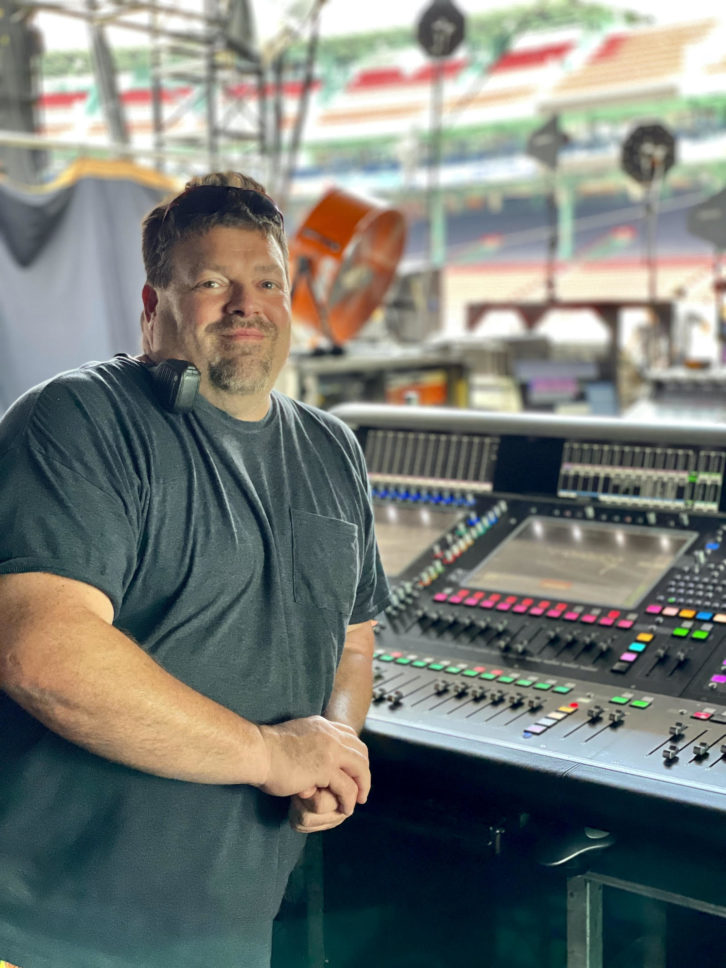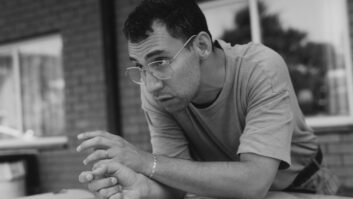
Mötley Crüe and Def Leppard are not known for their subtlety, so it’s only fitting that the rock titans’ co-headlining jaunt this summer was called simply The Stadium Tour. While it was first announced in 2019—with the Mötley clan tearing up its famous Cessation of Touring contract, no less—COVID put the kibosh on the metal mission until this year, which may be just as well. After a two-year drought of live music, audiences were starved for a good time, and the solid bill, which also featured veteran rockers Poison, the iconic Joan Jett & the Blackhearts and fresh-faced Classless Act, served up a satisfying seven hours of the hard stuff.
Careening across the U.S. through mid-September, the production sold an astounding 1.1 million tickets, making it one of the biggest tours of the year. Ensuring every note was heard in every seat at every stadium was audio provider Clair Global and a seasoned team of pros that had the production down to a science—by necessity.

“There were five back-to-backs early on and with that size stage and setup, it can be a little hectic,” said Scott Flaws, monitor engineer for Mötley Crüe singer Vince Neil. “Luckily, the audio team Clair put together has been killing it with us. Everyone understands the idea of teamwork and we have gotten to the point where production days are no longer needed. We’re getting in and out in one day: Do the show, load out, go take a day off in the hotel, get on site at 6 A.M., fly P.A., start dumping backline. Linecheck, linecheck, linecheck, linecheck, okay, first band go!”
The various audio teams shared more than a ‘can-do’ mindset, however, as crew chief/ RF coordinator Kenneth “Cubby” McDowell could attest. For one thing, they shared frequencies for the headliners’ in-ear monitor systems. “I have a spreadsheet to keep track of who has what,” said McDowell. “For instance, [Mötley Crüe guitarist] Mick Mars and Joe [Elliott, singer] from Def Leppard are on the same frequencies, so one has to turn off so the other can turn on. That’s the only way we can do the tour outside with the RF environment the way it is now; in some places, there’s really one open TV station—we’re putting frequencies in between other TV stations just to make it work. The tour has 70 active channels, and that’s no spares.”
Rage Against the Machine Returns to the Road
McDowell kept it all in check with a 17-space Clair rack with pocket screen, a Shure AXT600 Axient Spectrum Manager, Intermodulation Analysis System (IAS) software by Professional Wireless Systems to coordinate, and Shure’s Wireless Workbench for control. All the coheadliners’ wireless mics and IEM packs were Shure Axient Digital and PSM 1000 IEM systems. Providing RF and internet to the various camps, McDowell set up at stage left near the amp racks. “That way, I can keep an eye on everything and I’m accessible to my crew,” he said. “We put our P.A. up, and then work the rest of the day with all these bands. I wouldn’t ask my crew to do that and then go sit in an air-conditioned office.”
Getting that massive P.A. in the air was no small task either, as the tour required four semis’ worth of L-Acoustics loudspeakers to cover 270 degrees across the MBL and NFL stadiums it visited. The typical speaker arrangement found the stage adorned with left and right main hangs of 20 K1s over four K2s, each supplemented by eight K1-SBs; the same arrangement was used for outfills as well. Further afield, delay hangs were comprised of 16 K2s each, and low end for the whole system was fortified by 48 KS28s across the front of the stage; powering everything was a phalanx of LA12x amplifiers. While Classless Act kicked off the proceedings with a 20-minute set, and Joan Jett and Poison followed with an hour of solid rock each, the headliners alternated in the last two spots, each laying down the loud for 90 minutes.

MIXING MÖTLEY
“With Mötley Crüe, there’s no stopping; the only time there’s a break is when Tommy [Lee, drummer] comes downstage and talks to the audience for a minute before he sits down to play piano on ‘Home Sweet Home,’” said the band’s FOH engineer, Brent Carpenter. “Everything else segues or Vince or Nikki [Sixx, bassist] announces the next song. We run right up to 89, 90 minutes every night—right on the number.”
Mixing the band on an Avid S6L-32D surface controlling an E6L-192 engine, Carpenter tended to lean on the onboard effects, noting, “If I can keep it in-the-box, I do; I want less stuff to go bad on the outside.” That said, a trio of outboard Eventide 3500 Ultra-Harmonizers was on-hand to help represent all eras of the band. “You have to be aware of their legacy sound as well as their modern sounds, and represent them both,” he explained. “On the early records, there’s a lot of processing on the vocal as an effect, and the same happened in the more recent albums—The Dirt era—whereas in the middle section of their career, there didn’t seem to be as much processing, maybe just like a little chorus and a delay and that was it. So I have the Eventides to find that classic and recent Vince Neil vocal sound, just to do the spread, because nothing sounds like an Eventide.”

Mick Mars’ distinctive sound came solely from his three-cabinet guitar rig, with stereo effected cabinets each miked with an AKG C214 and a Shure KSM353 ribbon mic, while a “dry” cabinet between them was captured with a Shure SM57. “He’s also got what we call the Blues Cabinet, which has a Beta 56 on it, and I take a direct—a low end that he calls the Sub Guitar that’s just a Palmer PDI-09 direct box,” said Carpenter.
Meanwhile, Sixx’s bass came directly off his wireless into a pair of Ampeg tube DIs; one stayed clean while the other was effected with a McDSP Futzbox plug-in at FOH. “That’s been my staple for bass guitar since I worked with Rush,” said Carpenter. “It’s literally a noise plug-in, a heavy grind sound, so [between the two channels], you still get the nice warm, low end, round sound of the clean bass, but you get more of a top end and something to cut through the guitars.”
Dead & Company: Keeping It Live
Neil’s vocals were captured with a Shure SM58 capsule on an Axient Digital transmitter, while all backing vocals were nabbed with Telefunken M81s. Behind the drum kit, Lee’s headset mic changed a few times throughout the tour, as the first headset was deemed too bulky and another sounded great but “couldn’t take the rigors of Tommy’s playing,” said Carpenter. “Now we’re on a Shure TwinPlex and that’s working very well.” The rest of the drum area was captured with both a Telefunken M82 and a Shure Beta 91A in the kick drum, Audio-Technica AE3000s on toms as well as the snare bottom, and an SM57 on the snare top. For cymbals, an Audio-Technica ATM450 got the hi-hat, while a Neumann KM 184 grabs the ride, and the overheads were Audio-Technica AT4060s.

Over at stageside, a pair of DiGiCo SD7 consoles were used to mix the Mötley Crüe monitors, with Scott Flaws handling Neil’s mix on one, and Scott Megrath tackling the rest of the band’s mixes on the other. All of the bandmembers used JH Audio Sharona in-ear monitors, but each in his own way. While Sixx stuck to his IEMs, Mars and Lee wanted a little more feel; Mars got that from his guitar cabinets, but Lee had plenty of firepower, too, with three Clair Cohesion CP-218 subs plus a number of Cohesion CM-22 wedges for good measure. “It’s pretty incredible—and it sounds great,” said Megrath.
Neil, on the other hand, wore a single Sharona in his left ear, leaving the right open to take in sound from the house, a number of Clair SRM wedges, and sidefills comprised of CP-218s with Cohesion CO-10s on top. “They’re not set to Stun, but their presence up there is felt,” Flaws confirmed.
Tightening up the band’s IEMs was the Pearl, an upcoming personal DSP processor from JH Audio. “Basically, it’s a little DSP active processor that sits on the PSM 1000 belt pack, and we’re able to go in and time-align each earpiece,” said Megrath. “Say we’re making boosts at 3 or 4k; we’re able to make sure each driver is in time, phase aligned, all that kind of stuff. The band uses that and they love it.”
The band’s monitor mixes were essentially variations on the house-mix-with-me-louder paradigm, but when it came to getting Neil’s monitor mix right, Flaws had the added challenge of having joined the tour four shows in. While he had a history with the singer, having mixed Neil’s monitors on solo tours before the pandemic, coming into the production late in the game piled on the pressure. “The techs on stage are the guys that are setting me up for success,” he said. “Suddenly you’re on one of the largest stadium tours ever, you’re in the hot seat, and to come in with no rehearsals, it’s ‘Okay, guys, what am I jumping into?’ Scotty Megrath, Cubby and the guys in my Stage Left world said, ‘Okay, we’re going to do this’ and laid out such a plan—and it’s been very successful at this point. We did a couple of really good shows, it’s not broke, now let’s not fix it!”







